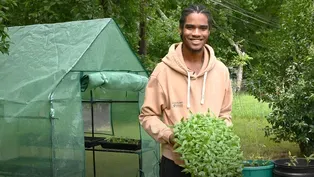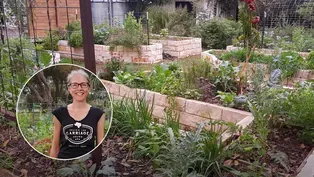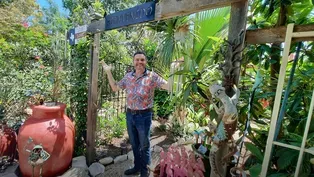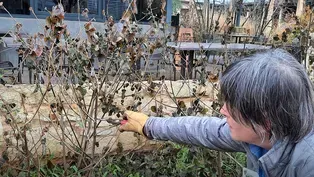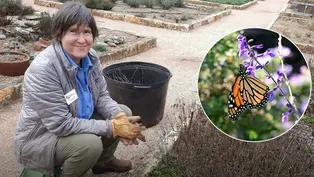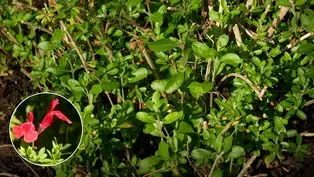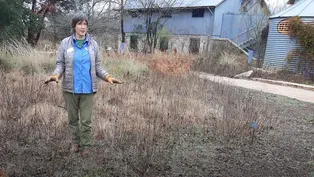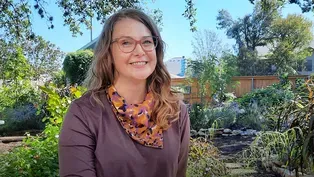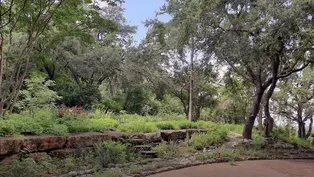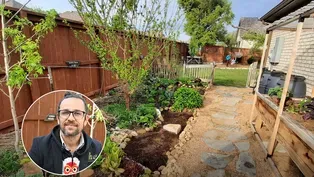
Winter Pruning: Wax Mallow for Spring’s Spiderworts
Clip: Season 28 | 3m 25sVideo has Closed Captions
See how to cut back wax mallow (turk’s cap) to show off spring-blooming spiderworts.
See how to cut back winter-dormant wax mallow (turk’s cap) with Leslie Uppinghouse, horticulturist at the Lady Bird Johnson Wildflower Center. Underneath, spiderwort’s green leaves fill the gap, sending up spring blooms for pollinators. Wax mallow’s summer-to-fall flowers and fruits attract bees, butterflies, hummingbirds and mammals.
Problems with Closed Captions? Closed Captioning Feedback
Problems with Closed Captions? Closed Captioning Feedback
Central Texas Gardener is a local public television program presented by Austin PBS
Support for CTG is provided by: Lisa & Desi Rhoden, and Diane Land & Steve Adler. Central Texas Gardener is produced by Austin PBS, KLRU-TV and distributed by NETA.

Winter Pruning: Wax Mallow for Spring’s Spiderworts
Clip: Season 28 | 3m 25sVideo has Closed Captions
See how to cut back winter-dormant wax mallow (turk’s cap) with Leslie Uppinghouse, horticulturist at the Lady Bird Johnson Wildflower Center. Underneath, spiderwort’s green leaves fill the gap, sending up spring blooms for pollinators. Wax mallow’s summer-to-fall flowers and fruits attract bees, butterflies, hummingbirds and mammals.
Problems with Closed Captions? Closed Captioning Feedback
How to Watch Central Texas Gardener
Central Texas Gardener is available to stream on pbs.org and the free PBS App, available on iPhone, Apple TV, Android TV, Android smartphones, Amazon Fire TV, Amazon Fire Tablet, Roku, Samsung Smart TV, and Vizio.
Providing Support for PBS.org
Learn Moreabout PBS online sponsorshipHi, I'm Leslie Uppinghouse.
We're here at the Lady Bird Johnson Wildflower Center.
And today we're talking about winter cutting back.
So what I am doing here is this is a year round garden.
This is a small space.
It's a long bed.
And what I'm trying to do is have color and interest all year long.
So the plant I'm cutting back is a wax mallow, and you can see that it's done with its show.
This is a summer and fall blooming plant.
I'm going to cut it completely to the ground to show off the giant spiderwort, which is the bright green underneath.
That will be your groundcover through the winter.
And then one of the first flowers to bloom in the spring.
So in order to do this, I'm using a lopper.
You could use a hand pruner or you could use a shear, but I would recommend a nice pair of loppers to make it quick and easy.
So I'm just going to show you how to cut it.
You're going to cut it all the way to the ground.
And if you notice on your woody plants, there are nodes and I'm going to cut it right above the node.
So I'm just pushing the spiderwort out of the way so I can make a nice clean cut and I'm just cutting off the branches.
Plant by plant all the way to the ground above the node.
It's important to have a sharp pair of pruners.
You don't want to damage that tissue, so make sure they're nice and sharp.
This type of cutting back doesn't take a lot of thinking, you're really concentrating on the why.
This is for design reasons and aesthetics.
Doesn't hurt the plant.
So now that the wax mallow is fully cut to the ground, you can really see the giant spiderwort underneath it.
This provides bright green ground cover for the winter.
And this will be one of the first flowers that blooms in very early spring.
It's a high flower, so it really does fill the space nicely.
And you wouldn't even know that there's a wax mallow planted underneath it until that spiderwort is completely done in late spring, right when that wax mallow starts to come up out of ground bright green.
So both the spiderwort and the turks cap are an edible food, but it also is a terrific pollinator food.
So with the early spring flowers, you have youre drawing in those very early pollinators, and then you want to have that late summer and fall pollination and the turks cap or wax mallow provides that, and it's a great plant for hummingbirds as well.
So this is a great example of how to pair two plants based on the shape and size and bloom time to squeeze into a small space to get more bang for your buck.
So for this wax mallow, I want to be clear that you don't have to cut this plant to the ground.
This is purely for design and aesthetics.
This plant can take pruning for just lowering the size of it or if you want to just cut it back a little bit and have fresh green growth at the top.
At a certain level, you can cut it at different times a year.
You can tip it when you want to.
So again, the wax mallow doesn't have to be cut to the ground every winter, but you can do that to have it come up very uniformly if you have a mass planting.
So for Backyard Basics, Im Leslie Uppinghouse.
Happy pruning.
Growing Community: Body and Soul
Video has Closed Captions
Lenny West found his anchor and mission in providing fresh vegetables to food desert neighbors. (6m 18s)
Native Plant Garden in HOA: Martin Byhower
Video has Closed Captions
A California-to-Texas environmentalist helps neighbors garden for wildlife in extreme weather. (8m 42s)
Permaculture Design: Raised Beds and Food Forest
Video has Closed Captions
Limestone raised beds and a mandala-designed food forest honor resourceful permaculture tenets. (9m 15s)
Creating Moods in a Regular Backyard
Video has Closed Captions
Imagination, creative reuse, and spirited fun turned a backyard into a sensory voyage. (7m 41s)
Video has Closed Captions
New gardener Nancy Hall relied on plants–adapted and native–to teach her their ways. (7m 49s)
Artistic Collaboration Goes with the Flow
Video has Closed Captions
When rainwater runoff plagued a family’s home, they plunged into a whimsical makeover. (8m 25s)
Winter Pruning: Wax Mallow for Spring’s Spiderworts
Video has Closed Captions
See how to cut back wax mallow (turk’s cap) to show off spring-blooming spiderworts. (3m 25s)
Winter Pruning: Mealy Blue Sage
Video has Closed Captions
See where to cut back old stalks on perennial mealy blue sage. (3m 16s)
Video has Closed Captions
Learn how to prune this evergreen woody shrub/subshrub. (4m 47s)
Video has Closed Captions
See why to progressively prune grasses and herbaceous perennials. (1m 35s)
Garden Makeover Grows New Friends and Career
Video has Closed Captions
Jennie Ostertag broke a few shovels changing her yard and life’s path. (9m 18s)
Video has Closed Captions
James Truchard created diverse habitats to offset a future of climate changes. (8m 49s)
Drought Design: Change of Plans & Plants
Video has Closed Captions
Mistakes led new gardeners back to the drawing board with native plants. (8m 55s)
Side Yard Garden Permaculture Design
Video has Closed Captions
A narrow side yard supports food and flowers with permaculture techniques. (8m 1s)
Front Yard Native Plant Wildlife Habitat
Video has Closed Captions
Removing lawn for native plants brings pollinators to a young couple’s front yard. (9m 35s)
Providing Support for PBS.org
Learn Moreabout PBS online sponsorshipSupport for PBS provided by:
Central Texas Gardener is a local public television program presented by Austin PBS
Support for CTG is provided by: Lisa & Desi Rhoden, and Diane Land & Steve Adler. Central Texas Gardener is produced by Austin PBS, KLRU-TV and distributed by NETA.
